Overview
To strengthen your core and abs, it is essential to incorporate effective exercises such as planks, Russian twists, and bicycle crunches into your routine. The article emphasizes that these exercises not only enhance core stability and overall fitness but also contribute to improved workplace motivation and reduced absenteeism, highlighting the broader benefits of physical fitness in a corporate environment.
Introduction
In the pursuit of a healthier workplace, understanding the significance of core and abdominal strength is paramount. These foundational muscles not only enhance physical performance but also play a crucial role in fostering motivation and emotional well-being among employees.
As HR Benefits Managers recognize the profound impact of fitness on workplace dynamics, the push for tailored core training programs becomes essential. Engaging in effective core workouts not only reduces absenteeism but also cultivates a culture of resilience and productivity.
By prioritizing core strength, organizations can empower their teams to thrive, setting the stage for improved performance and overall health. This article delves into the vital components of core strength, effective exercises, common pitfalls to avoid, and strategies for integrating fitness into daily routines, all aimed at enhancing the well-being of employees and the workplace as a whole.
Understanding Core and Abdominal Strength: The Foundation of Fitness
The strength of the core and abs serves as the cornerstone for stability, balance, and overall physical performance, directly influencing workplace motivation and emotional well-being. The center includes essential muscles, such as the rectus abdominis, obliques, and transverse abdominis, each playing a crucial role in spinal and pelvic support during movement. Research has indicated that a strong center not only enhances athletic performance but also plays a crucial role in injury prevention by offering improved support during various physical activities, which can lead to increased employee motivation.
Recent studies indicate that customized training programs are essential for optimizing sport-specific performance—underscoring the need for HR Benefits Managers to advocate for such initiatives. A study in the journal 'Preventive Medicine' revealed that employees who participate in regular physical activity, including exercises for their core and abs, report higher levels of motivation and lower fatigue and stress, positively impacting their productivity. Specifically, these employees were 15% more likely to report feeling motivated at work compared to those who did not engage in physical activity.
Additionally, findings from the journal “Workplace Health & Safety” highlighted that participation in workplace exercise programs resulted in a 20% reduction in absenteeism and presenteeism, showcasing the significant impact of physical fitness on overall workplace engagement. Kuan Dong from the Graduate School of Physical Education at Myongji University states, 'These results indicate that it is essential to properly structure foundational development programs to enhance sport-specific athletic performance.' Moreover, a noteworthy study on older adults demonstrated that effective training of the core and abs significantly reduces fall risk, helping this demographic overcome fears associated with falling.
However, it is important to note the study's limitations, which focused solely on abdominal strength, endurance, and flexibility, suggesting a need for further research on trunk strength and stability tests. By understanding and emphasizing the foundational role of essential muscles, HR Benefits Managers can foster comprehensive fitness routines that promote health, well-being, and resilience across their teams, ultimately enhancing motivation and workplace performance.
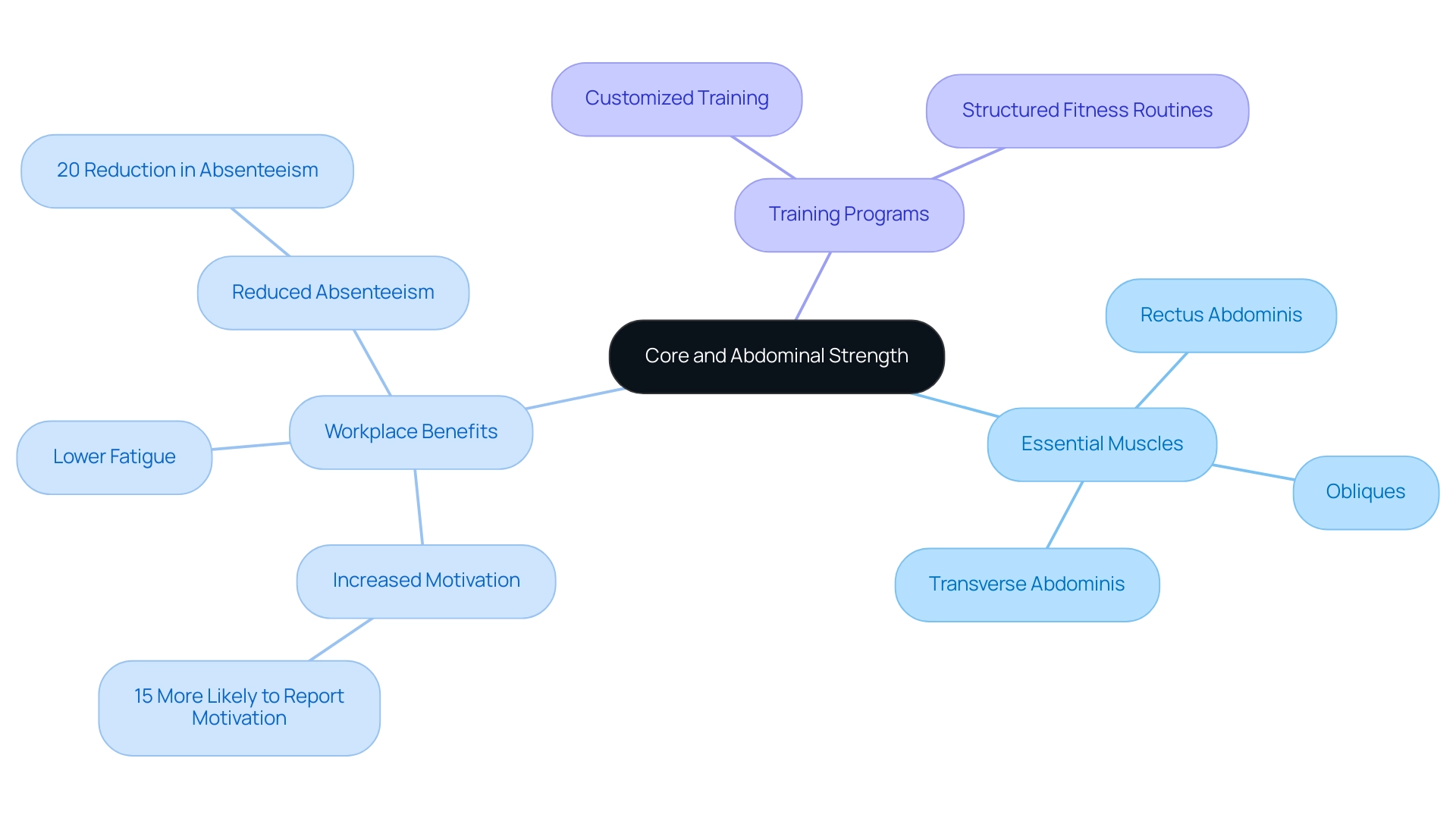
Effective Exercises for Strengthening Your Core and Abs: A Step-by-Step Approach
Enhancing your core and abs is essential for overall fitness, and incorporating effective exercises into your routine can yield significant benefits. Here’s a step-by-step guide to some of the most effective abdominal workouts:
- Plank: Begin in a push-up position, ensuring your body forms a straight line from head to heels. Engage your center and hold this position for 30 seconds to 1 minute. This activity builds endurance and stability in your core and abs.
- Russian Twists: Sit on the floor with your knees bent and lean back slightly. Holding a weight or medicine ball, twist your torso to the right, then to the left. Aim for 10-15 repetitions on each side. This movement not only targets the obliques but also enhances rotational strength, crucial for various physical activities.
- Bicycle Crunches: Lie on your back with your hands behind your head. Bring your knees towards your chest, lifting your shoulders off the ground. Alternate bringing your right elbow to your left knee and vice versa. Perform 15-20 repetitions. This dynamic activity engages the core and abs, enhancing coordination.
- Dead Bug: Start by lying on your back, arms extended towards the ceiling, and knees bent at 90 degrees. Slowly lower one arm and the opposite leg towards the ground, then return to the starting position. Repeat for 10-12 repetitions on each side. This exercise is excellent for enhancing stability and coordination in the core and abs.
Incorporate these exercises into your routine 2-3 times a week for optimal results. Reliability is essential, as research shows that participating in fundamental exercises can result in enhanced performance in activities like vertical jumping. Butcher et al. reported an increase in take-off velocity in the vertical jump after nine weeks of foundational exercises, showcasing the tangible benefits of these workouts. Additionally, the longest follow-up in the studies was three months, suggesting a reasonable timeframe for observing results. By committing to these exercises, you're not only investing in your own health but also setting a powerful example for your team, reinforcing the importance of well-being in the workplace.
It's worth mentioning that the studies backing these claims adhered to PRISMA guidelines and registered their protocols on PROSPERO, emphasizing the methodological rigor behind primary program effectiveness.
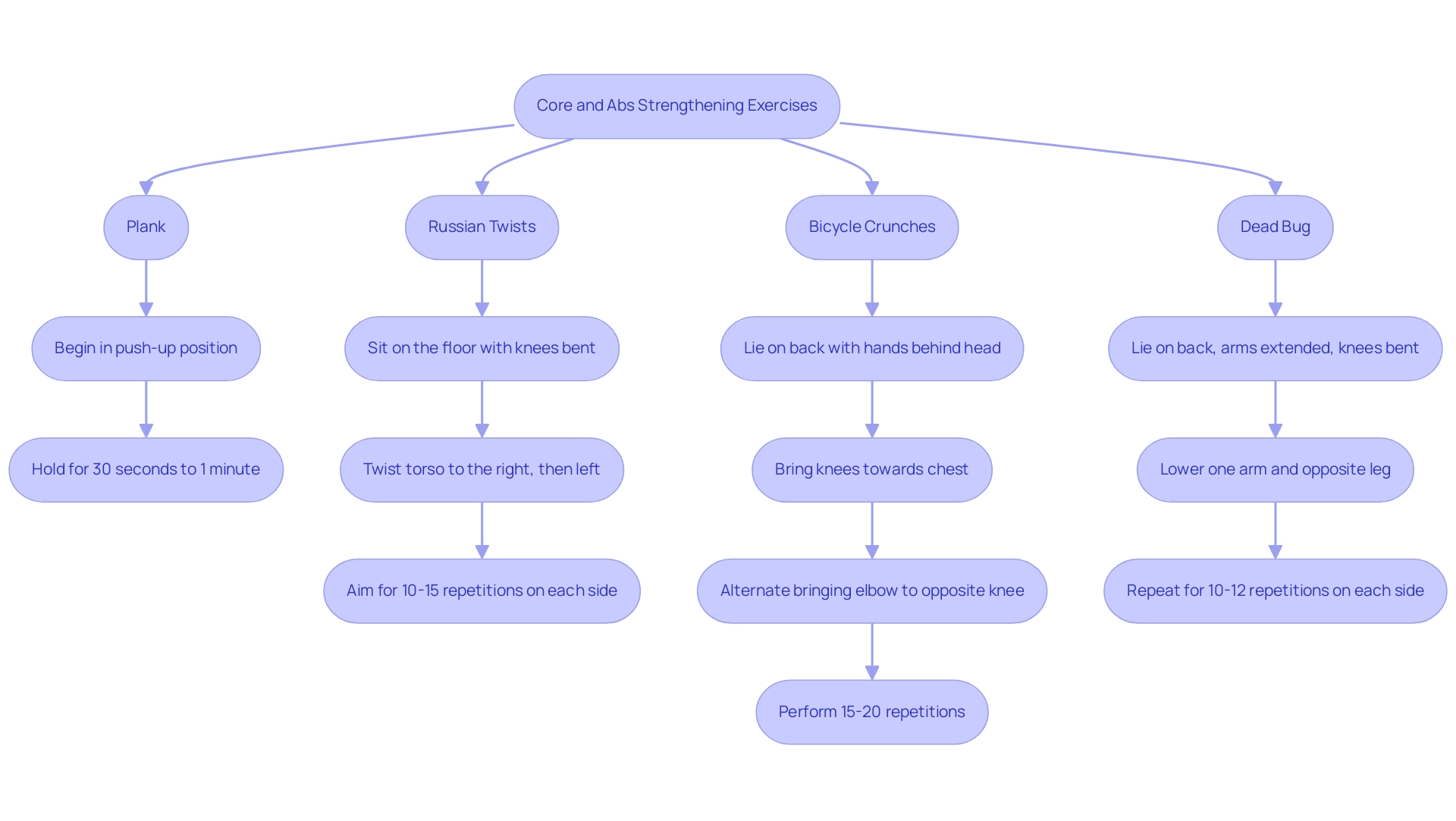
Avoiding Common Mistakes in Core and Ab Training
To maximize the effectiveness of your fundamental workouts, it's crucial to avoid these common mistakes that can hinder progress and lead to injuries:
- Neglecting Form: Always prioritize maintaining proper form over the number of repetitions. As many fitness professionals highlight, poor technique not only compromises the effectiveness of your workout but can also increase the risk of injury. Stuart McErlain-Naylor emphasizes that 'to determine whether the two effect sizes were significantly different, you would need to directly compare them in a single test.' This principle emphasizes the significance of evaluating your fundamental training methods effectively.
- Overtraining: Your central body areas require sufficient time to recuperate. Overworking them daily can lead to fatigue, ultimately diminishing your results. A balanced approach that allows for recovery is essential for building strength effectively.
- Ignoring Other Muscle Groups: A strong core and abs are foundational to overall fitness. Incorporating activities that involve different muscle groups promotes balance and stability, which are essential for improving central strength. This holistic approach ensures that your center is not isolated but supported by a well-rounded fitness regimen that incorporates exercises for core and abs.
- Holding Your Breath: Effective breathing is essential during workouts that target the core and abs. Focus on exhaling during exertion and inhaling during the relaxation phase. This technique not only maintains central engagement of the core and abs but also enhances oxygen flow, further improving the efficacy of workouts.
- Performing Exercises Too Quickly: Research indicates that executing exercises for core and abs too quickly can reduce their effectiveness. Slower movements with a focus on time under tension are more beneficial, allowing for greater muscle engagement and better results.
By being mindful of these common pitfalls, you position yourself to significantly enhance your training effectiveness. Remember, abs typically begin to show at around 15% body fat, so implementing these strategies not only helps you achieve better results but also promotes overall well-being for you and your team.
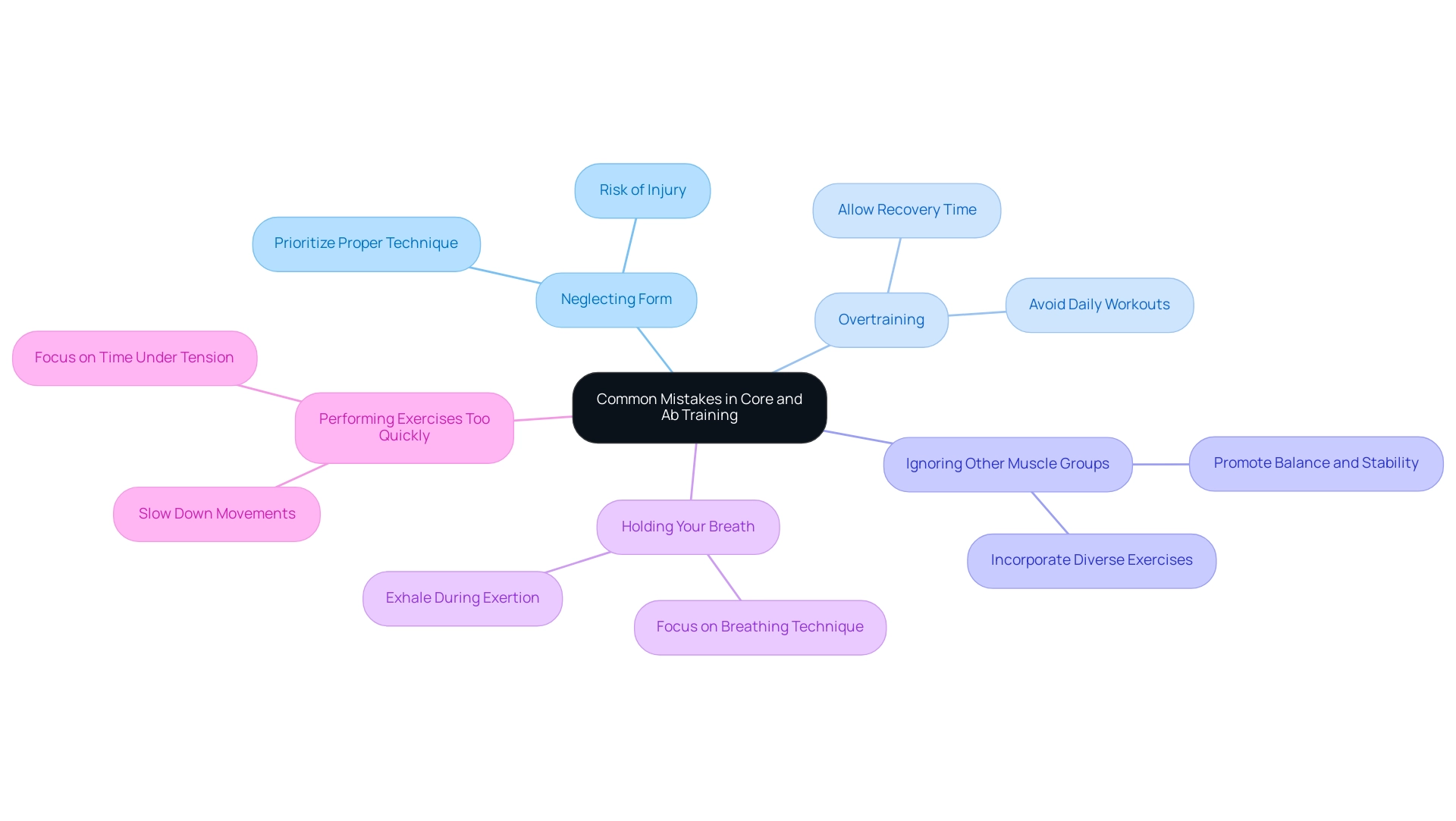
Integrating Core Workouts into Your Daily Routine: Tips and Strategies
To seamlessly integrate essential workouts into your daily routine as part of a corporate wellness initiative, consider these empowering strategies:
- Plan Brief Workouts: Dedicate only 10-15 minutes daily for fundamental activities. The key to success lies in consistency—short, regular sessions can yield impressive results over time. Additionally, working out at home can save you up to $1,000 annually compared to gym memberships, making it a financially smart choice that reflects your commitment to employee well-being.
- Utilize Downtime Effectively: Make the most of your breaks or the time spent watching TV by incorporating essential exercises like planks or seated twists. These simple moves can be performed virtually anywhere, maximizing your efforts and aligning with the trend of integrating fitness into daily life, crucial for maintaining mental sharpness and productivity.
- Blend with Other Activities: Engage your core and abs during your standard workouts, whether you’re doing cardio or strength training. This integration not only enhances your routine but also strengthens the habit of fundamental engagement, reflecting the fitness industry's focus on personalized experiences that support overall health and cognitive performance.
- Buddy Up: Partner with a colleague or friend to keep each other motivated. Working out together increases accountability, making it 45% more likely for you to stick to your routine and 63% more likely to maintain it over the long haul. As highlighted in a study by Tate et al., those whose physical activity expenditure exceeds 2,500 calories per week have significantly lower weight regain rates (2.9 vs. >6 kg), underscoring the importance of maintaining a consistent fitness routine in a supportive work culture.
Additionally, consider incorporating personalized coaching and structured wellness plans as part of your corporate wellness program. These services can provide tailored guidance to help employees stay engaged and committed to their fitness goals. By implementing these strategies and support systems, you can effortlessly integrate fundamental training into your daily life, paving the way for a healthier and more active lifestyle—an essential part of fostering a thriving workforce.
Remember, maintaining a consistent exercise routine not only enhances individual well-being but also plays a crucial role in reducing absenteeism, reinforcing the benefits of integrating fitness into your daily schedule as part of a comprehensive wellness program.
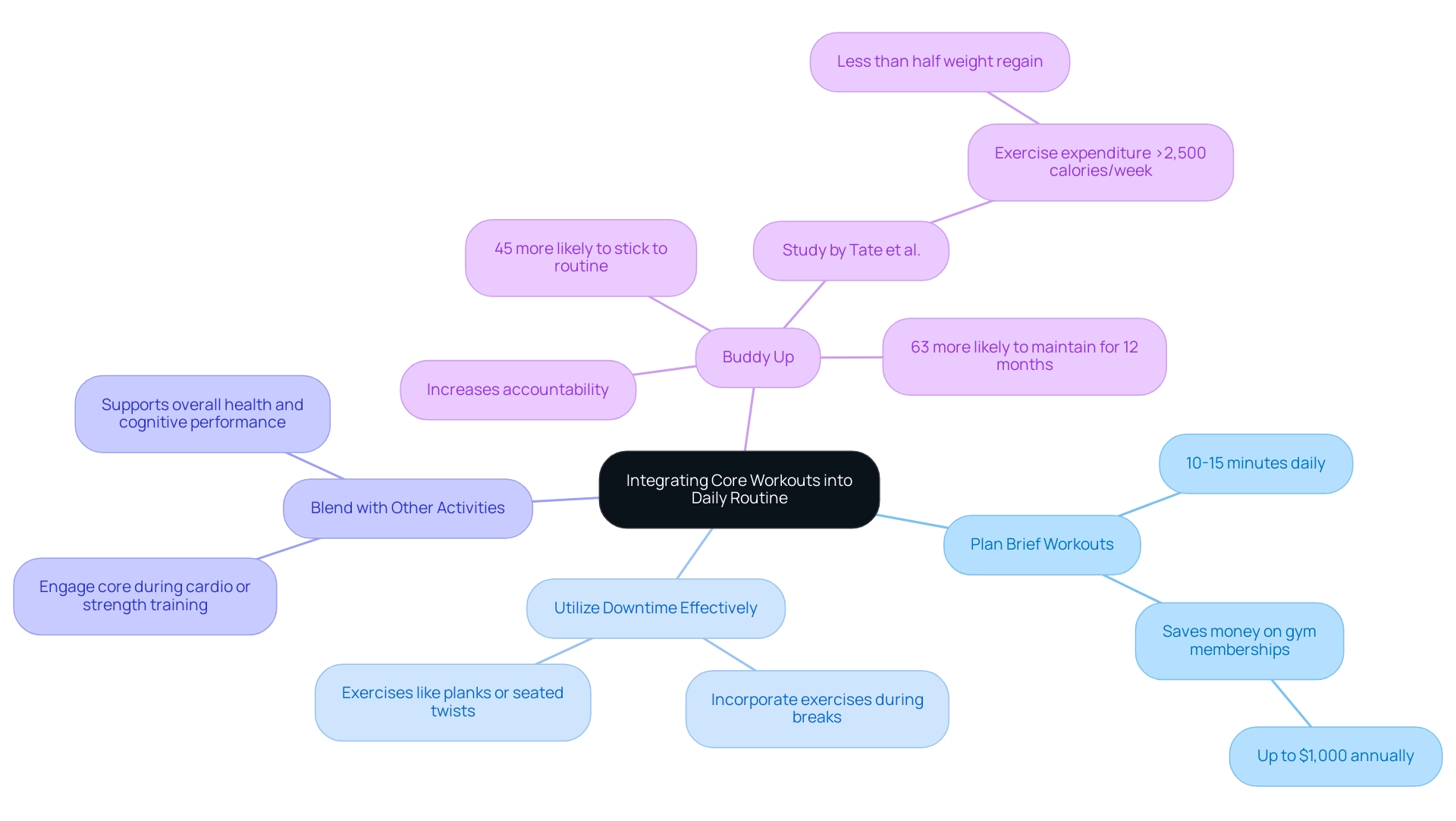
The Role of Nutrition and Recovery in Core Strength Development
To maximize your core strength, it is crucial to prioritize nutrition and recovery:
-
Eat a Balanced Diet: Focus on a diverse range of nutrients—lean proteins, healthy fats, and complex carbohydrates are essential for fueling workouts and enhancing recovery. Research indicates that daily protein intake for those engaged in physical training should range from 0.8 to 2.1 g/kg of body mass, highlighting the need to tailor dietary choices to your activity levels.
Recent findings suggest that whey protein consumption post-exercise can lead to small-medium beneficial effects on function restoration, consistent with previous studies.
-
Stay Hydrated: Hydration is pivotal for optimal bodily function and recovery. Aim for at least 8 cups of water daily, but adjust this amount based on your exercise intensity and duration.
Sufficient hydration aids not only recovery but also overall athletic performance.
-
Prioritize Sleep: Strive for 7-9 hours of quality sleep each night. Sleep plays a vital role in muscle recovery and maintaining overall health, as restorative sleep cycles help to repair muscles and replenish energy stores.
-
Incorporate Active Recovery: On rest days, engage in low-intensity activities such as walking or stretching. This promotes blood flow, aids recovery, and prepares your body for subsequent workouts.
-
Consider Supplementation: A systematic review on arginine supplementation found that both acute and chronic use could lead to substantial improvements in athletic performance.
This highlights the potential of such supplements as ergogenic aids, which can complement a well-rounded nutrition strategy. By emphasizing nutrition and recovery strategies, you can significantly enhance the development of your core and abs strength and improve your overall fitness outcomes. As Merry, T. L. succinctly states,
The bottom line is that physiological doses (from the diet) are beneficial, whereas supraphysiological doses (supplements) during exercise may be detrimental to one's gains and recovery.
Remember, effective recovery is as crucial as training itself, and the right nutritional strategy will pave the way for your success.
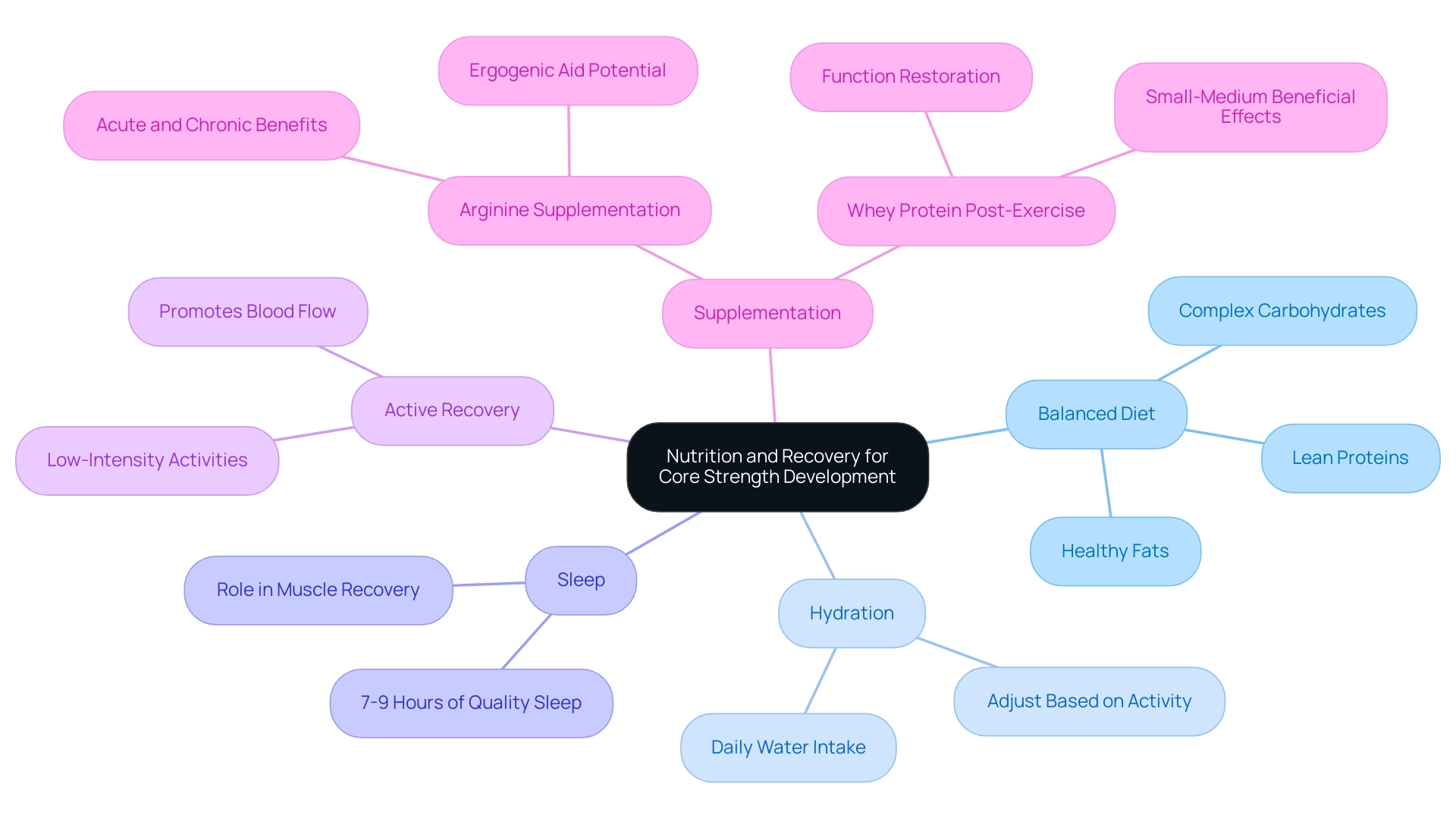
Conclusion
Emphasizing core and abdominal strength is vital for fostering a healthier workplace environment. By understanding the foundational role of these muscles, HR Benefits Managers can advocate for tailored core training programs that not only enhance physical performance but also boost employee motivation and emotional well-being. Engaging in effective core workouts has been shown to reduce absenteeism and presenteeism, creating a more resilient and productive workforce.
Incorporating effective exercises into daily routines can yield significant benefits. Simple yet powerful movements like:
- Planks
- Russian twists
- Bicycle crunches
can be seamlessly integrated into schedules, even during breaks. Moreover, avoiding common pitfalls such as neglecting form and overtraining ensures that employees maximize their workout effectiveness while minimizing the risk of injury.
Nutrition and recovery play an equally crucial role in developing core strength. A balanced diet, proper hydration, and adequate sleep are essential for muscle recovery and overall fitness. By prioritizing these elements, organizations can support their employees in achieving their fitness goals, thus reinforcing a culture of health and well-being.
Ultimately, the commitment to developing core strength within the workplace not only empowers individuals but also enhances the collective performance of teams. By championing these initiatives, HR Benefits Managers can lead the way toward a thriving work environment where health and productivity go hand in hand. Now is the time to take action and prioritize core strength as a fundamental aspect of workplace wellness.
Frequently Asked Questions
Why is core strength important for workplace performance?
Core strength is crucial for stability, balance, and overall physical performance, which directly influences workplace motivation and emotional well-being.
Which muscles are considered essential for core strength?
The essential muscles include the rectus abdominis, obliques, and transverse abdominis, all of which support the spine and pelvis during movement.
How does core strength relate to injury prevention?
A strong core provides improved support during physical activities, which can help prevent injuries and enhance athletic performance.
What impact does regular physical activity have on employee motivation?
Employees who engage in regular physical activity, including core and abdominal exercises, report higher motivation levels and lower fatigue and stress, making them 15% more likely to feel motivated at work.
What are the benefits of workplace exercise programs?
Participation in workplace exercise programs can lead to a 20% reduction in absenteeism and presenteeism, significantly improving overall workplace engagement.
What did research from the Graduate School of Physical Education at Myongji University reveal about foundational development programs?
The research highlighted the need to properly structure foundational development programs to enhance sport-specific athletic performance.
How can training the core and abs benefit older adults?
Effective training of the core and abs can significantly reduce fall risk in older adults, helping them overcome fears associated with falling.
What limitations were noted in the studies regarding core training?
The studies primarily focused on abdominal strength, endurance, and flexibility, indicating a need for further research on trunk strength and stability tests.
How can HR Benefits Managers promote health and well-being in the workplace?
By understanding the foundational role of essential muscles, HR Benefits Managers can foster comprehensive fitness routines that promote health, well-being, and resilience, ultimately enhancing motivation and workplace performance.

